30.09.2023
Aditya L1 successfully escapes sphere of Earth's influence, navigating its path to Lagrange Point 1: ISRO
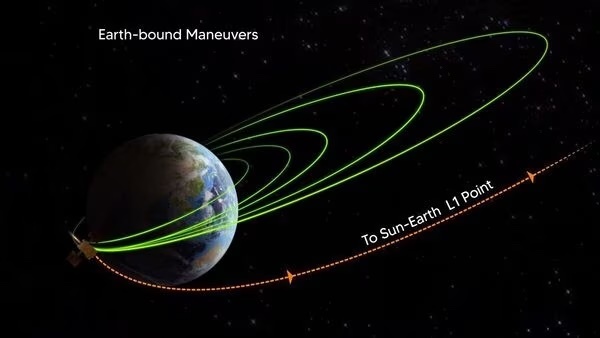
“Off to Sun-Earth L1 point! The Trans-Lagrangian Point 1 Insertion (TL1I) manoeuvre is performed successfully. The spacecraft is now on a trajectory that will take it to the Sun-Earth L1 point. It will be injected into an orbit around L1 through a maneuver after about 110 days", ISRO had said in a post on X.
Exciting news! Mint is now on WhatsApp Channels :rocket: Subscribe today by clicking the link and stay updated with the latest financial insights! Click here!
1.5 million kilometers journey
Aditya-L1 is slated to placed in a halo orbit encircling Lagrangian Point 1, positioned at a staggering 1.5 million kilometers from our planet, directly aligned with the Sun's trajectory. This ambitious journey is projected to span a period of four months. Once established in its orbit, Aditya-L1 will maintain a constant distance of approximately 1.5 million kilometers from Earth, a minuscule fraction of the vast Earth-Sun separation.
Quelle: mint
----
Update: 7.10.2023
.
“Aditya L1 spacecraft escapes sphere of earth’s influence”: ISRO
Indian Space Research Organisation (ISRO) on Saturday informed that the Aditya-L1 spacecraft has successfully escaped the sphere of Earth’s influence adding that it is now navigating its path towards the Sun-Earth Lagrange Point 1 (L1).
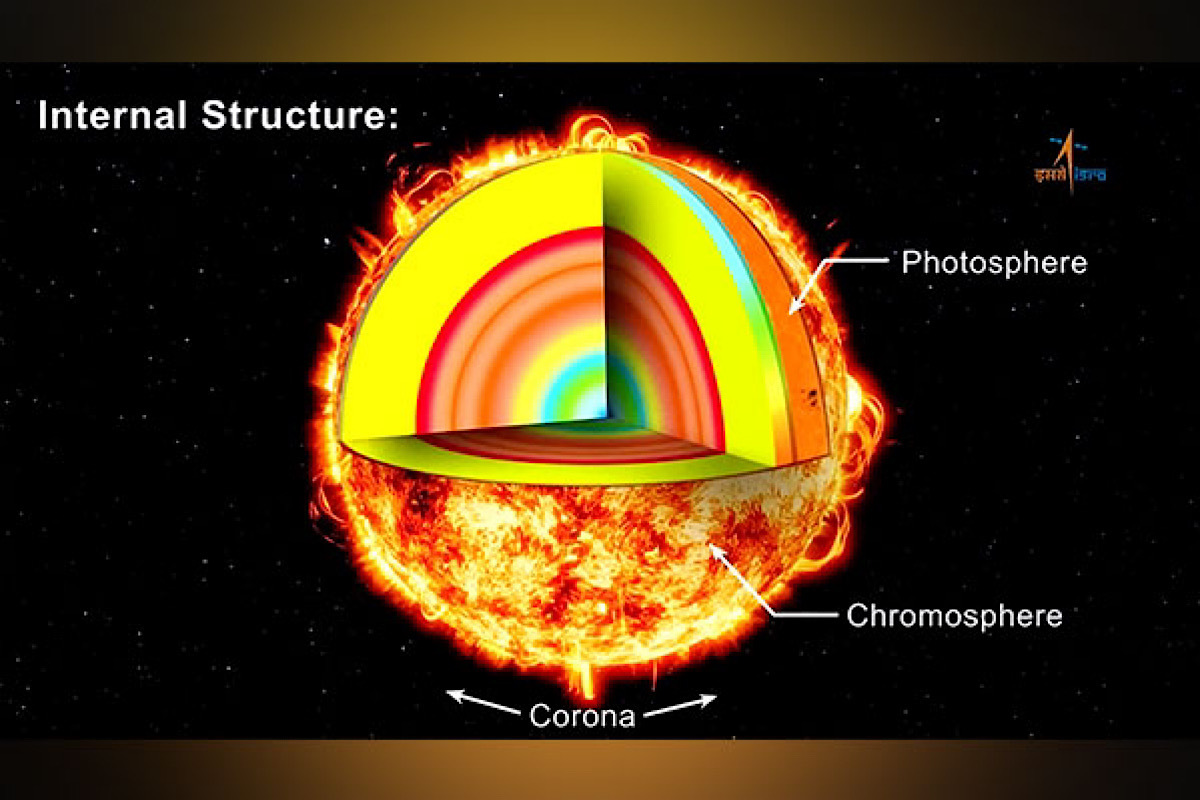
Indian Space Research Organisation (ISRO) on Saturday informed that the Aditya-L1 spacecraft has successfully escaped the sphere of Earth’s influence adding that it is now navigating its path towards the Sun-Earth Lagrange Point 1 (L1).
Taking to X (former Twitter), ISRO said, “The spacecraft has travelled beyond a distance of 9.2 lakh kilometres from Earth, successfully escaping the sphere of Earth’s influence. It is now navigating its path towards the Sun-Earth Lagrange Point 1 (L1).”
ISRO further stated that it is the second time in succession that the space agency could send a spacecraft outside the sphere of influence of the Earth with the first time being the Mars Orbiter Mission (Mangalyaan).
The PSLV-C57.1 rocket carrying the Aditya-L1 orbiter lifted off successfully from the Satish Dhawan Space Centre in Sriharikota, Andhra Pradesh on September 2.
The successful launch of the maiden solar mission of the Indian Space Research Organisation (ISRO) came on the heels of the historic lunar landing mission — Chandrayaan-3.
According to the agency, the Aditya-L1 mission is expected to reach the observation point in four months. It will be placed in a halo orbit around Lagrangian Point 1 (or L1), which is 1.5 million km away from the Earth in the direction of the sun.
It will carry seven different payloads to have a detailed study of the sun, four of which will observe the light from the sun and the other three will measure in-situ parameters of the plasma and magnetic fields.
Major objectives of India’s solar mission include the study of the physics of solar corona and its heating mechanism, the solar wind acceleration, coupling and dynamics of the solar atmosphere, solar wind distribution and temperature anisotropy, and origin of Coronal Mass Ejections (CME) and flares and near-earth space weather.
Quelle: The Statesman
----
Update: 16.10.2023
.
India's Aditya-L1 solar observatory on course for its sunny parking spot 1 million miles from Earth
The sun-studying spacecraft is on a 110-day journey to its gravitationally stable vantage point.
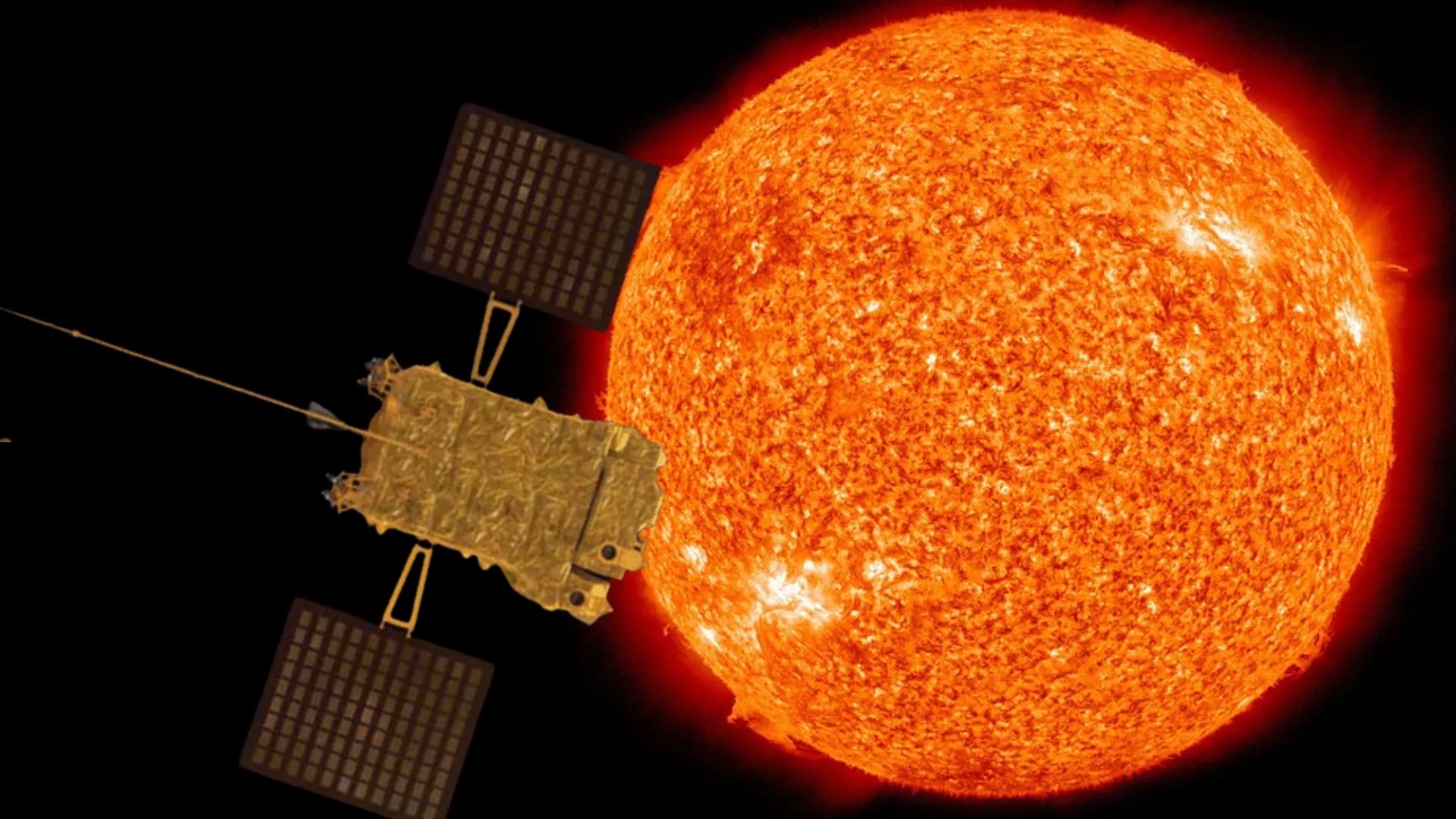
India's first solar observatory has made a trajectory correction maneuver to ensure it is on course for a special point in space to observe the sun.
India launched Aditya-L1 on Sept. 2, sending the spacecraft on a 110-day voyage to an area in space around 1 million miles (1.5 million kilometers) from Earth. Aditya-L1 is planned to settle into a halo orbit around Earth-sun Lagrange point1, a gravitationally stable area from which the spacecraft will have an uninterrupted view of the sun.
"A Trajectory Correction Maneuver (TCM), originally provisioned, was performed on October 6, 2023, for about 16 seconds," according to the India Space Research Organisation's (ISRO) X social media account.
ISRO previously wrote in a post on X (formerly Twitter) on Sept. 30 that Aditya-L1 had successfully escaped the Earth’s sphere of influence. The TCM, which is a standard procedure for deep space missions, was executed to fine tune the spacecraft’s orbit.
"It was needed to correct the trajectory evaluated after tracking the Trans-Lagrangean Point 1 Insertion (TL1I) maneuver performed on September 19, 2023," ISRO wrote.
Aditya-L1 carries seven payloads for its five-year-long mission to study the sun. It is the second time India as sent a spacecraft beyond the Earth’s sphere of influence, the first being the the Mars Orbiter Mission (MOM), which launched in October 2013 and arrived in orbit around the Red Planet in 2014.
"Aditya" means "the sun" in Sanskrit, while the mission's L1 suffix comes from the location from which it will operate.
Quelle: SC
----
Update: 2.12.2023
.
Solar wind particle experiment payload onboard Aditya-L1 starts operations: ISRO
Aditya-L1 is the first Indian space-based observatory to study the Sun from a halo orbit around first Sun-earth Lagrangian point (L1), which is located roughly 1.5 million km from Earth.
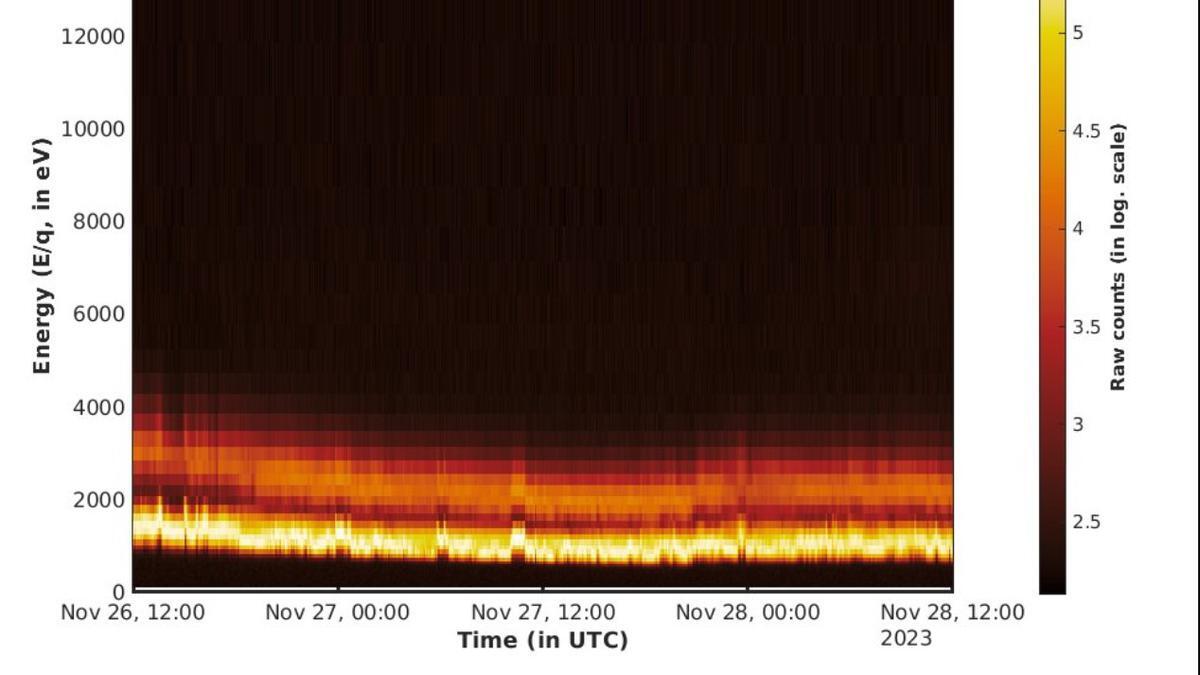
The Solar Wind Ion Spectrometer (SWIS), the second instrument in the Aditya Solar wind Particle Experiment (ASPEX) payload is operational. The histogram illustrates the energy variations in proton and alpha particle counts captured by SWIS over 2-days. Twitter/@isro
Aditya-L1 Mission: The Indian Space Research Organisation (ISRO) Saturday said that its observatory class solar aircraft Aditya-L1 has started studying solar winds after it activated Solar Wind Ion Spectrometer instrument aboard the spacecraft.
“The Solar Wind Ion Spectrometer (SWIS), the second instrument in the Aditya Solar wind Particle Experiment (ASPEX) payload is operational. The histogram illustrates the energy variations in proton and alpha particle counts captured by SWIS over 2-days,” ISRO said in a post.
Soon after the activation, the SWIS payload sent the first picture of the sun’s solar winds. The ISRO also said that SWIS also captured the energy variations in proton and aplha particle counts and shared a histogram illustration of the Aditya-L1 observations.
Aditya L1, India’s first space-based solar mission, was launched from the Satish Dhawan Space Centre at Sriharikota in Andhra Pradesh on September 2.
Aditya L1 is India’s first space-based observatory class solar mission that will stay approximately 1.5 million km away from Earth. The solar mission will study the outer atmosphere of the sun over the next four years.
Aditya L1 spacecraft is carrying seven payloads – Visible Emission Line Coronagraph(VELC), Solar Ultraviolet Imaging Telescope (SUIT), Solar Low Energy X-ray Spectrometer (SoLEXS), High Energy L1 Orbiting X-ray Spectrometer(HEL1OS), Aditya Solar wind Particle Experiment(ASPEX), Plasma Analyser Package For Aditya (PAPA), and Advanced Tri-axial High-Resolution Digital Magnetometers.
Quelle: The Statesman
----
Update: 10.12.2023
.
India's Aditya-L1 solar observatory captures 1st gorgeous views of the sun (images)
The spacecraft has exited Earth's sphere of influence and is about a month away from reaching its cosmic accommodations at L1.
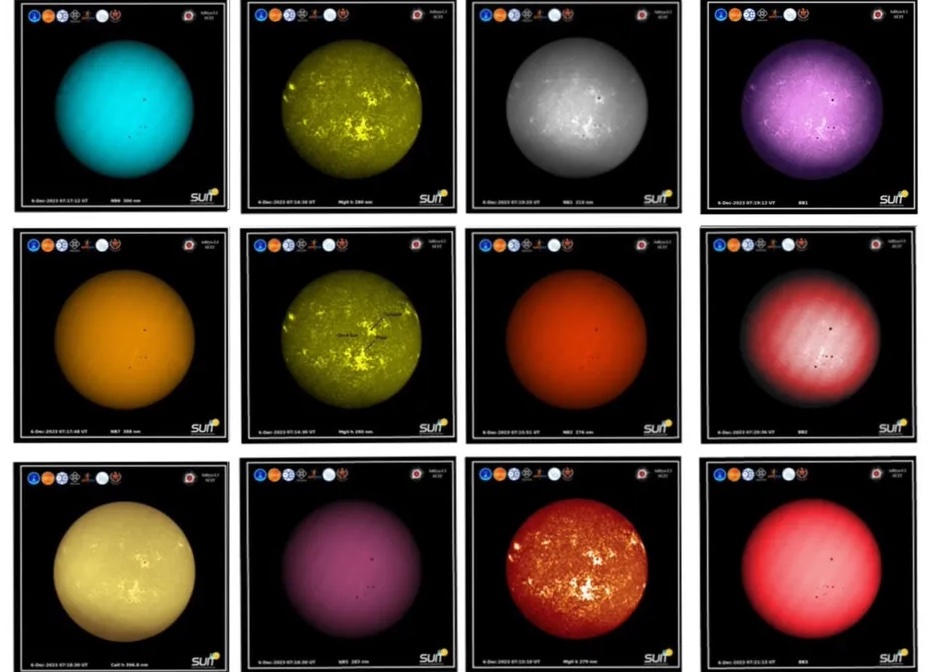
The SUIT payload onboard Aditya-L1 spacecraft captured the sun's full disk on first light earlier this week (Image credit: ISRO) (Image credit: ISRO)
An instrument onboard India's first sun-studying observatory has officially opened its scientific eyes and sent home beautiful images of our star.
The pictures, captured earlier this week by a payload named SUIT (short for Solar Ultraviolet Imaging Telescope), reveal a handful of features on the sun's surface, including a few sunspots, a solar "plage" and some silent, inactive areas.
It is a "lifetime opportunity to conceive a space telescope & get to see its first light observations," Durgesh Tripathi, SUIT's principal investigator, said in a poston X (formerly Twitter) on Friday (Dec. 8).
Scientists turned on the instrument on Nov. 20, according to a statement by the Indian Space Research Organisation (ISRO), which is operating the Aditya-L1solar observatory in collaboration with multiple institutions located in Ahmedabad, Pune and Kerala.
The sun, of course, is a roiling ball of plasma. So rather than a solid, rocky surface like Earth's, the sun's visible "surface" is really a thin envelope of hydrogen and helium called photosphere. It is about 62 miles (100 kilometers) thick and home to sunspots, or dark, planet-size regions of intense magnetic fields from which powerful solar flares blast out. Sometimes, these plasma jets travel toward us, like those that spurred a recent "cannibal" solar storm that initiated gorgeous auroras around the world.
Aditya-L1's latest images capture four clear sunspots, including one very close to the sun's equator. Our star appears to be calmer to its left, labeled in the image as "quiet sun." Below the equator, you'll notice another feature called the plage, a very hot region usually seen in the chromosphere, which is the layer of the sun's atmosphere above the photosphere but underneath its corona.
The Aditya-L1 spacecraft lifted off on Sept. 2 from India's spaceport in Sriharikota on a four-month journey to L1 orbit, a vantage point in spaceapproximately 1 million miles (1.5 million kilometers) from Earth. From this region, the probe can observe the sun continuously and also remain somewhat stable by using minimal fuel and requiring just a few orbital maneuvers.
The spacecraft flung past the sphere of Earth's gravitational influence in late September; it will reach its final cosmic accommodations later this month or early next. Then, its seven science instruments are expected to begin studying how solar wind particles behave after blasting from the sun, while also monitoring our star for upcoming solar flares.
The mission team has started switching on other payloads onboard Aditya-L1 too. Last week, for instance, ISRO announced the Aditya Solar wind Particle Experiment (ASPEX) instrument, meant to study the composition of solar wind by in-situ observations, was performing as expected. On Friday (Dec. 8), another payload designed to monitor solar wind was also turned on and declared to be in good health, the space agency said in a different statement.
Scientists hope to use data from this mission to predict solar flare activity and their companions, coronal mass ejections.
Quelle: SC
----
Update: 5.01.2024
.
ISRO to perform crucial manoeuvre on January 6 to bind Aditya-L1 into L1 orbit
Aditya-L1 the first Indian space based observatory to study the Sun was launched on September 2, 2023 from the Satish Dhawan Space Centre in Sriharikota.
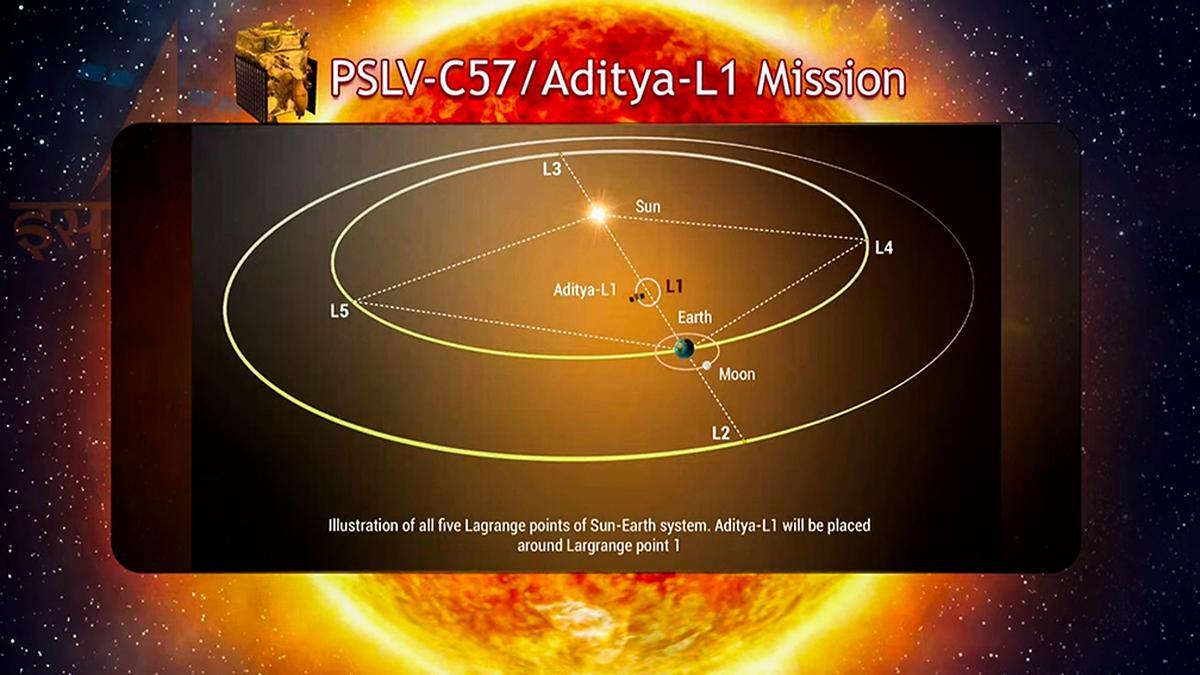
L1 is about 1.5 million km from the Earth and the distance of L1 from Earth is approximately 1% of the Earth-Sun distance. | Photo Credit: ANI
With the Aditya L1 spacecraft expected to reach the Lagrangian point (L1) on January 6the Indian Space Research Organisation (c) will attempt a crucial manoeuvre to bind the spacecraft to an orbit around L1.
Aditya-L1, the first Indian space based observatory to study the Sun was launched on September 2, 2023 from the Satish Dhawan Space Centre in Sriharikota.
Subsequently, ISRO Telemetry Tracking and Command Network (ISTRAC) in Bengaluru carried out four earth-bound manoeuvres between September 3 and September 15.
Aditya-L1 on September 19 underwent the Trans-Lagrangian1 insertion manoeuvre, marking the beginning of its 110-day trajectory to the destination around the L1 point.
L1 is about 1.5 million km from the Earth and the distance of L1 from Earth is approximately 1% of the Earth-Sun distance.
On January 6 at approximately around 4 pm ISRO Scientists and Engineers from the Mission Operations Complex of ISTRAC will perform the crucial manoeuvre which will bind Aditya-L1 to an orbit around L1.
The propulsion system of the spacecraft comprises the 440 Newton Liquid Apogee Motor (LAM) engine plus eight 22 Newton thrusters and four 10 Newton thrusters which will be intermittently fired to perform the manoeuvre.
According to ISRO a satellite placed in the halo orbit around the L1 point has the major advantage of continuously viewing the Sun without any occultation/eclipse. This will provide a greater advantage of observing the solar activities continuously.
Aditya-L1 carries seven payloads to observe the photosphere, chromosphere, and the outermost layers of the Sun (the corona) using electromagnetic and particle detectors.
Using the special vantage point of L1, four payloads will directly view the Sun and the remaining three payloads will carry out in-situ studies of particles and fields at the L1.
Aditya-L1 has a mission life of five years during which its payloads are expected to provide the most crucial information to understand the problem of coronal heating; coronal mass ejection; pre-flare and flare activities and their characteristics; dynamics of space weather; and propagation of particles and fields.
There are currently four operational spacecraft at L1 which are WIND, Solar and Heliospheric Observatory (SOHO), Advanced Composition Explorer (ACE) and Deep Space Climate Observatory (DSCOVER).
- ISRO’s Aditya L1 spacecraft is expected to reach the Lagrangian point (L1) on January 6 will attempt a crucial manoeuvre to bind the spacecraft to an orbit around L1.
- On January 6 at approximately around 4 pm ISRO Scientists and Engineers from the Mission Operations Complex of ISTRAC will perform the crucial manoeuvre which will bind Aditya-L1 to an orbit around L1.
- Aditya-L1 carries seven payloads to observe the photosphere, chromosphere, and the outermost layers of the Sun (the corona) using electromagnetic and particle detectors.
Quelle: The Hindu
----
Update: 8.01.2024
.
Aditya-L1: India’s solar mission reaches sun’s orbit
After four-month journey, Aditya-L1 will measure and observe sun’s outermost layers

India’s solar observation mission has entered the sun’s orbit after a four-month journey, the latest success for the space exploration ambitions of the world’s most populous country.
The Aditya-L1 mission was launched in September and is carrying an array of instruments to measure and observe the sun’s outermost layers.
India’s science and technology minister, Jitendra Singh, said on social media that the probe had reached its final orbit “to discover the mysteries of sun-Earth connection”.
The US and the European Space Agency have sent numerous probes to the centre of the solar system, beginning with Nasa’s Pioneer programme in the 1960s. Japan and China have also launched their own solar observatory missions into Earth’s orbit.
India’s prime minister, Narendra Modi, hailed it as another landmark in the country’s space programme. “It is a testament to the relentless dedication of our scientists,” he said on social media. “We will continue to pursue new frontiers of science for the benefit of humanity.”
Aditya, named after a Hindu sun deity, has travelled 932,000 miles (1.5m km) from Earth – still only 1% of the distance between Earth and the sun. It is now at a point where the gravitational forces of both celestial bodies cancel out, allowing it to remain in a stable halo orbit around the sun.
The orbiter, which reportedly cost $48m (£38m), will study coronal mass ejections, a periodic phenomenon in which huge discharges of plasma and magnetic energy are released from the sun’s atmosphere. These bursts are so powerful they can reach the Earth and disrupt the operations of satellites.
The mission also aims to shed light on the dynamics of several other solar phenomena by imaging and measuring particles in the sun’s upper atmosphere.
India has a comparatively low-budget space programme, but one that has grown in size and momentum since it first sent a probe to orbit the moon in 2008. In August last year, India became the first country to land an uncrewed craft near the largely unexplored lunar south pole, and the fourth country to land on the moon.
India became the first Asian country to put a craft into orbit around Mars in 2014 and it is expected to launch a three-day crewed mission into Earth’s orbit later this year.
India is also planning a joint mission with Japan to send another probe to the moon by 2025 and an orbital mission to Venus within the next two years.
Quelle: The Guardian
----
Update: 26.01.2024
.
ISRO successfully deploys magnetometer boom on board Aditya-L1 spacecraft
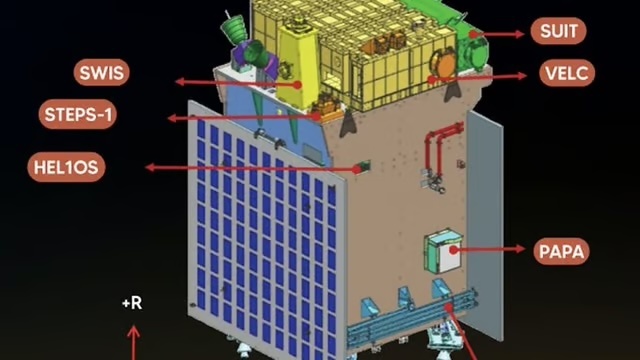
BENGALURU: ISRO has successfully deployed the magnetometer boom on board the Aditya-L1 satellite to measure the low intensity interplanetary magnetic field in space.
The six-metre-long magnetometer boom is deployed in the Halo orbit at the Lagrange point L-1, on January 11, the space agency said, noting that the boom had been in stowed condition for 132 days since the Aditya-L1 launch.
According to ISRO, the boom carries two state-of-the-art, high-accuracy fluxgate magnetometer sensors that measure the low intensity interplanetary magnetic field in space.
"The sensors are deployed at distances of 3 and 6 metres from the spacecraft body. Mounting them at these distances minimises the impact of the spacecraft-generated magnetic field on measurements, and using two of them assists precise estimation of this influence. The dual sensor system facilitates cancelling out the spacecraft's magnetic influence," it said.
The boom segments are constructed from carbon fibre reinforced polymer and serve as interfaces for the sensor mounting and mechanism elements, ISRO said.
The articulated boom mechanism comprises five segments interconnected through spring-driven hinge mechanisms, allowing for folding and deploying actions, it was noted.
India's maiden solar mission Aditya-L1 reached the L1 point, located roughly 1.5 million km from earth enabling the spacecraft to view the sun continuously, on January six, 127 days after it was launched on September 2, 2023.
The solar observatory at L1 is aimed at observing and understanding the chromospheric and coronal dynamics of the Sun continuously.
Quelle: The New Indian Express
